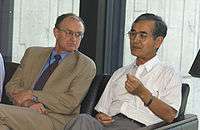Yoji Totsuka

Yoji Totsuka (戸塚 洋二 Totsuka Yōji, March 6, 1942 – July 10, 2008) was a Japanese physicist and Special University Professor, Emeritus, University of Tokyo. Totsuka died on July 10, 2008 from colorectal cancer.
His doctoral advisor - the Nobel Prize winning physicist Masatoshi Koshiba was told that if Totsuka can extend his lifespan by eighteen months, he must receive the prize.[1]
Early life
Totsuka was born March 6, 1942 in Fuji, Shizuoka Prefecture. He completed his B.S. in 1965, his M.S. in 1967 and his Ph.D. in 1972 from the University of Tokyo.
Academic career
Totsuka became a Research Associate at the University of Tokyo in 1972, followed by seven years at Deutsches Electron Synchrotron (DESY) in Germany, where he investigated electron–positron collisions. Subsequently, he became an Associate Professor of the University of Tokyo from 1979 to 1987. In 1987, he was promoted to full Professor at the University of Tokyo. He later became the Director of the Kamioka Observatory, part of the Institute for Cosmic Ray Research (ICRR) at the University of Tokyo in 1995 and then Director of the Institute for Cosmic Ray Research in 1997. In 2003, Totsuka became the Director General of the High Energy Accelerator Research Organization (KEK).
Research

Totsuka's career in neutrino physics began following his time at DESY, when he began working as part of the Kamiokande experiment with Nobel prize winner Masatoshi Koshiba. The experiment, though designed to detect proton decay, actually ended up successfully measuring the first and so far only neutrinos from a cosmogenic source on Earth, from SN 1987A, along with the Irvine–Michigan–Brookhaven (IMB) detector in the US.
The success of Kamiokande, through Totsuka's leadership, led to the funding of a substantially larger water Cherenkov detector in 1991, the storied Super-Kamiokande (Super-K) detector, which is still an active international collaboration. It was at Super-K that the first definitive evidence for neutrino oscillations was measured, via a high-statistics, high-precision measurement of the atmospheric neutrino flux. Super-K also confirmed, along with the Sudbury Neutrino Observatory (SNO), the solution to the solar neutrino problem.
The measurement of neutrino oscillations at such a high level of precision was a critical chapter in the history of particle physics. Neutrino oscillations, and thus the existence of neutrino mass, are not a prediction made by the Standard Model of particle physics. Indeed, the Standard Model requires that neutrinos are massless. Totsuka's experiment provided incontrovertible evidence that there is still much about particle physics yet to be understood.
For the remainder of his time as a physicist, as the Director General at KEK, he oversaw successful the K2K experiment and the Belle B-meson "factory".
Personal life
When he left physics, towards the end of his life, Totsuka turned his attention to communicating with the Japanese public about his illness, science, and culture. He maintained a blog, The Fourth Three-Months, where he candidly discussed the extent, progress, and treatment of his cancer. Totsuka also revealed an interest in gardening, particularly the flowers in the area where he spent much of his career, in Mozumi, the village where Super-K is located.
Awards and honors
- Asahi Prize, 1987
- Nishina Memorial Prize, 1988
- Bruno Rossi Prize, (American Astronomical Society),1989
- Inoue Prize for Science, 1990
- EPS Special Prize, European Physical Society, 1995
- Order of Culture, 2004
- Benjamin Franklin Medal in Physics, 2007
See also
References
- ↑ 文藝春秋2008年9月号.
- "Biography of Yoji Totsuka". Retrieved 2007-11-02.
- "Franklin Institute Awards in 2007". The Franklin Institute Awards. Retrieved 2007-11-02.
- "Obituary: Yoji Totsuka (1942–2008)". Nature 454, 954 (21 August 2008). Retrieved 2009-07-25.